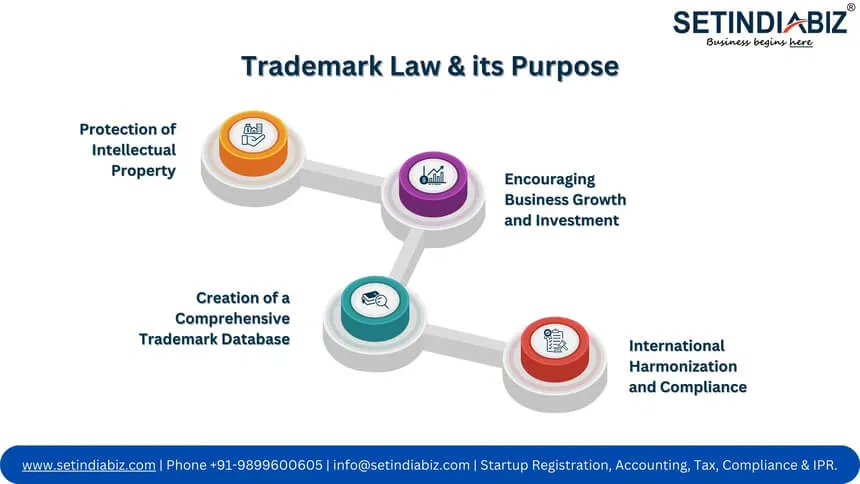Trademark Meaning, Objective and Infringement
Overview : The objectives of Trademarks stand unparalleled in building Brand Recognition and ensuring Brand Protection for businesses in India and all over the world. Let’s explore what these objectives really are and how they can be achieved under the Trademark law.
Trademarks are unique marks of identity used to represent a business brand in the market. It could be anything, from the name of the brand, to its logo, its tagline, a unique colour combination used in its product packaging, and so on. Hence it’s clear that the primary objective of Trademarks is to enhance the recognition of a brand in the market. The more unique and appropriate a Trademark is, the better this objective is achieved. But is that all? Certainly not!
The objective of a Trademark extends not just to brand recognition but also brand protection. Businesses rely on their trademarks for effective marketing of their products in order to build a loyal consumer base. But can this objective be achieved if the Trademark gets stolen, copied and misused by other brands as well? Obviously not! This is called Trademark Infringement and it directly compromises the objectives which Trademarks seek to achieve. Our goal here is to explain the objectives of a Trademark in depth and analyse how Trademark Infringement compromises it in entirety. But before we proceed, it is important to first understand what Trademark really is.
Trademark Meaning
Section 2(zb) of the Indian Trademarks Act, 1999 defines a trademark as a mark which differentiates the products or services of a business in the market so that consumers can identify their origin easily. Any symbol, word, phrase, design, or expression which fulfills this objective can be considered a Trademark. Trademarks can be owned by a business itself or an individual representing the business who currently uses the Trademark commercially or intends to do so in the future.
A trademark can be classified into different types:
- Word Mark: These are words, letters or numbers used to represent a brand. For example, the brand name, the tagline, the name of a popular product, etc.
- Device Marks: Device marks are trademarks that depict words, letters, or numbers in a distinctive way through a design element. For example – logos or products labels
- Service Marks: A service mark is simply a mark that identifies one person’s services from those of another. Service marks do not represent items, but rather the services provided by an individual or corporation.
- Collective Marks: A collective mark is a mark owned by an association of Persons, a governmental institution, or body Corporate collectively. These marks indicate that they originated from a group of individuals and not a single person.
- Certification Marks: A certification trade mark under Section 2 (1)(e) of the Trademarks Act, 1999, are trademarks which are used to certify that a product meets certain quality or safety standards set forth by a concerned authority.
- Well-known Marks: Section 11(9) requires a request in TM-M to declare a mark as a well-known trademark that is easily recognized by the mass of people. People are not allowed to register or use marks that are copied from well-known marks.
- Unconventional Trademarks: Unconventional trademarks are the most easily recognized trademarks because of their impressive, decisively unique characters. Examples include:
- Color Trademark: If a certain color has a distinguishing feature identifying the goods of a specific dealer, it can be registered as a trademark. For example, red wine.
- Sound Marks: Sound marks are signs that are detected by hearing and are distinguished by their own and exclusive sound. Consider musical notes.
- Shape Marks: When the shape of a product or package has a distinguishing trait, it might be registered. Consider Ornamental Lamps.
- Smell Marks: A smell mark can be detected when the smell is unique and cannot be confused with a related product. Perfumes, for example.
Trademark Law & its Purpose
Trademarks in India are governed by the all encompassing Trademark Law, the Trademark Act of 1999. This law not just outlines the legal definition of Trademarks as discussed above, but also governs all other aspects of it, such as Trademark Registration, Trademark Rights, and Trademark Infringements. Let’s look into the purpose of the Trademark law a little more deeply.

- Protection of Intellectual Property: The primary purpose of the Trademark Act is to provide legal protection to the intellectual property rights of a Trademark Owner. For this, the act establishes frameworks of Trademark Registration, Trademark Enforcement and remedies against Trademark Infringement to prevent the unauthorized use of a Trademark.
- Creation of a Comprehensive Trademark Database: The procedure of Trademark Registration under the Trademark Act enables the development of a comprehensive database of Trademarks with their real time statuses mentioned for public viewing and inspection. This ensures transparency and easy access to any updated information about Trademarks.
- Encouraging Business Growth and Investment: The use of Trademarks under the framework of Trademark law enhances the goodwill and trustworthiness of a brand, thereby encouraging more and more investors to invest in it and propel its growth and expansion.
- International Harmonization and Compliance: The Trademarks Act of 1999 aligns with international trademark standards, including the obligations under the Agreement on Trade-Related Aspects of Intellectual Property Rights (TRIPS) and the Nice Classification system. This promotes harmonization with global trademark practices and facilitates international trade while enhancing India’s compliance with international agreements.
Objectives of a Trademark
As already mentioned in the beginning of this blog, the ultimate objectives of trademarks are brand recognition and brand protection in the market. But how exactly are these objectives accomplished? Moreover are these the only objectives trademarks have? Let’s see!
1. Brand Recognition
Trademarks are used to uniquely recognize and distinguish a brand’s products or services in the market. Let’s understand with the help of an example. Say, you visit the market to buy a T-shirt, but you do not know which brand to choose. Now, when you reach the shop, the shopkeeper shows you T-shirts which have product labels on them. You instantly recognize the label and know what brand the specific product belongs to. This is how Trademarks aids in Brand Recognition.
2. Brand Protection against Copycats
Trademarks are considered Intellectual Properties and their use grants Intellectual Property Rights to the owner. These include the exclusive right to own and control the use of the mark throughout India. Moreover, any infringement of these rights can be legally challenged and remedies or damages can be sought from the unauthorized user. We will explain Trademark Infringement further in this blog.
3. Brand Communication to the Public
Trademarks are an effective business communication tool for capturing the attention of customers. Customers who see a trademark quickly know who they are dealing with, the company’s reputation, and are less inclined to explore alternatives. For instance, the brand name and logo may be the ultimate influence to a customer’s buying choice.
4. Registered Trademark is Considered the Most Valuable Asset
Many brands throughout the world place a higher value on their trademark than any other tangible asset. Brand value is only earned when the organization has total ownership of the brand name via trademark protection.
5. Trademarks increases the Employment Opportunities for a Brand
It is interesting to know how brands as Trademarks can influence people’s minds in different ways. Candidates who are interested in career opportunities may be inclined towards a brand which is known for employee retention and have good reviews about its products and services.
6. Trademarks Can be Used on the Internet Efficiently
Everything is at your fingertips in this digital realm. If a company or organization uses its Trademarks on social media as a channel for brand awareness, there are possibilities that strong traffic on a website or social media platform converts into better rankings, generating even more traffic, consumers, and resulting in better brand recognition.
Remember, the more your Trademark is distinct from other businesses, the easier it is to preserve. Choose a name and logo that distinguishes your company’s products and services aptly from the competition. Once a trademark has acquired such value, it is very important to safeguard it from misuse and infringement by others.
What is Trademark Infringement?
Trademark infringement is the unauthorized use of a mark that is identical or deceptively similar to a registered trademark. ‘Deceptively similar’ here refers to the fact that when an ordinary customer looks at the mark, he or she is likely to be confused about the origin of its products or services. The Trademarks Act of 1999 establishes the legal framework governing trademark infringement in India. Besides this act, there are many international and national organizations that work to preserve trademarks against infringement activities. For instance, The Indian Patent Office, which is overseen by the Controller General of Patents, design and Trademarks, is in charge of protecting Trademarks in India against infringement.
According to the Trademark Act, 1999, a trademark is infringed
- If the infringing trademark is a replication of a registered trademark with minimal changes or modifications.
- If the infringing trademark is printed or used in advertising.
- If the infringing trademark is used in business.
- If the infringing trademark is used in a way that is deceptively similar to a registered trademark, and is likely to trick the customer about the origin of its products.
In the course of infringement of a registered trademark, the trademark owner has the right to sue the infringer and claim monetary damages. The following requirements must be completed to file such a suit:
- The complainant also known as the plaintiff must be the registered owner of the trademark.
- The defendant must have used the ‘deceptively similar’ trademark to the plaintiff’s in a way that they were misled with one another.
- The defendant’s usage is not by chance but intentional and deliberate.
- The defendant’s use of the mark must be in the process of providing similar products or services to those for which the trademark is registered.
Penalties of Trademark Infringement
Trademark infringement in India is a punishable offense, which means that the infringer will face some serious criminal prosecution in addition to civil sanctions. The registration of a trademark is also not necessary by Indian law for the institution of civil or criminal actions. This is related to the common law idea of passing off.
The court might grant the following remedies in cases of trademark infringement:
- Temporary Injunction
- Permanent Injunction
- Damages
- Profit and loss statement (damages in the amount of the profits gained from the infringement)
- Destruction of items bearing an infringing trademark
- The expense of legal procedures
Conclusion
Understanding Trademark meaning is significant as they serve to distinguish and identify the origin of goods or services of a business in the market. A trademark’s objective lies in establishing brand recognition, loyalty, and exclusivity, enabling businesses to forge a distinct identity. However, trademark infringement poses a threat, undermining these objectives by confusing consumers and diluting brand value.
Vigilance against infringement and taking swift legal action is essential to protect intellectual property. By understanding Trademark Meaning, pursuing its Objectives, and combating Infringement, individuals and businesses can preserve their unique identities and foster innovation in a fair competitive environment.
FAQ's
Trademark registration grants exclusive rights of usership to the owner of the mark, making it easier to prevent others from using a similar mark that may cause confusion or dilute the trademark owner’s brand.
A registered trademark helps consumers identify your brand easily and makes it stand out from the competition. This helps in enhancing brand’s credibility and trustworthiness.
Trademark registration provides exclusive rights of usership to the Trademark owner and gives him the authority to take legal actions against others using a similar mark.
Trademark registration establishes your exclusive ownership rights nationally, giving you confidence to expand your business without infringing on others’ rights in India and simplifies the registration process for your Trademark in the new international markets you want to expand.
Trademark registration offers legal protection to the concerned trademark against plagiarism and misuse, making it easier for the trademark owner to enforce his IP rights in the event of a dispute. Also, ™ Registration helps in enhancing brand recognition by assisting consumers identify and differentiate your brand from the competitors.
Author Bio

Editorial Team | in
Setindiabiz Editorial Team is a multidisciplinary collective of Chartered Accountants, Company Secretaries, and Advocates offering authoritative insights on India’s regulatory and business landscape. With decades of experience in compliance, taxation, and advisory, they empower entrepreneurs and enterprises to make informed decisions.
